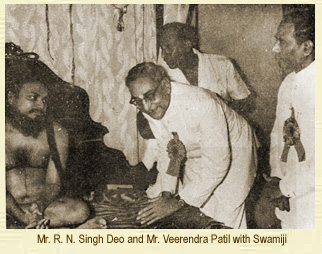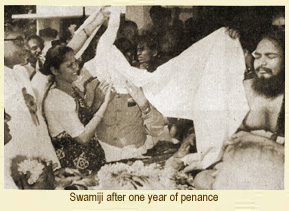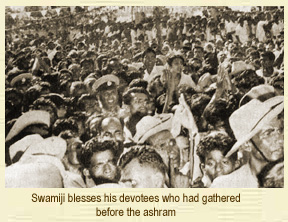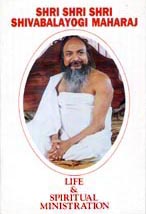![]()
|
|
ABOUT Spiritual Ministration │
PRINTER FRIENDLY PDF
PREVIOUS CHAPTER │
NEXT CHAPTER
Shri Shri Shri Shivabalayogi Maharaj Life & Spiritual Ministration
5.
Prachara
3 Tapas of the Four Directions
Download printer-friendly PDF of Spiritual Ministrations
Spiritual Ministration is now published as an
E-BOOK
through Handloom Publishing at Lulu.com
The Tours Start: 1963
After completing the Yuga Tapas on 7th August 1961, Sri Shivabalayogi Maharaj continued to reside at the Adivarapupeta Ashram for the next two years. In 1963, one Sri Bhag Singh Lamba, who was the Salt Commissioner for that region as also the President of the Adivarapupeta Ashram Committee, submitted to Sri Swamiji that he had acquired a suitable site for an Ashram at Dehra Dun and was keen on donating it to him. With this in view, he requested Sri Swamiji to plan a short visit to Dehra Dun stating as an added incentive that the place he had selected was in a secluded spot with quiet and peaceful surroundings. Sri Swamiji tentatively agreed to this request, but as he had promised Tapaswiji Maharaj that he would visit his various Ashrams when he completed his Tapas, Sri Swamiji decided to go to these Ashrams first. It was thus that Sri Swamiji started on the first of his many tours, which were to eventually embrace the length and breadth of India.
This first tour started on 21st March 1963. Sri Swamiji went first to Kakinada, where he stayed for four days in Sri Tapaswiji Maharaj’s Ashram. From there he proceeded to Madras halting en route at a number of places. At Madras, Sri Swamiji stayed at the Padmanabha Temple at Adiyar and gave public darshan for three days. From Madras Sri Swamiji proceeded to Sri Tapaswiji Maharaj’s Ashram located in the Nandi Hills. After staying for approximately 19 days at this Ashram, Sri Swamiji came to Doddaballapura, where he opened a small branch Ashram of the Sri Shivabalayogi Maharaj Trust. He stayed at this Ashram for 45 days. During this period, a large number of visitors came from Bangalore for the darshan of Sri Swamiji. Among these visitors was one Sri Kasetti Srinivasalu, proprietor of the Sita Lakshmi Hall, who made repeated requests to Sri Swamiji to come to Bangalore and open an Ashram there. Sri Swamiji agreed to this request and so Sri K. Srinivasalu donated an acre of land for the proposed Ashram on the Bannerghatta Road and had an Ashram building constructed on this land. This Ashram was opened by Sri Swamiji on 7th August 1963.
After opening the Bangalore Ashram, Sri Swamiji decided to stay on for a few days. The fame of Sri Swamiji spread rapidly in Bangalore, both by word of mouth and through the local press, and people began coming to the new Ashram in large numbers. This soon attracted the notice and envy of some of the older Ashrams in and around the city of Bangalore, particularly for the reason that their own adherents started flocking to the new Ashram at Bannerghatta Road as a result of which attendance at these Ashrams dropped down sharply. In order to counter this trend, they at first tried to spread slanderous lies about Sri Swamiji and about the activities of his Ashram. But this only served to further advertise Sri Swamiji’s Ashram; many, who had not heard earlier about Sri Swamiji, learnt about him from the propaganda being done against him and so, merely impelled by curiosity, they went to see the new Swami; they were so impressed by what they saw that they eventually stayed on and became devotees. Dismayed by the fact that their hostile propaganda was only serving to enhance the popularity of Sri Swamiji, the more unscrupulous among the ‘Math-Adipatis’ (Heads of Maths) stooped to hiring ‘goondas’ (ruffians) to intimidate the devotees going to Sri Swamiji’s Ashram and to disturb and break up the Kirtan parties there. This plan also did not work because devotees, particularly those who were under the influence of ‘Bhava’ during the Kirtan, belaboured these goondas and drove them away from the Ashram. When all their nefarious designs were thus frustrated these Math-Adipatis, in desperation, hired a band of notorious goondas to beat up the inmates of the Ashram, including Sri Swamiji himself!
As Sri Swamiji remained immersed in samadhi most of the time, he was usually unaware and indifferent to what went on around him. Because of this, Sri Swamiji was not yet in the know of the various attempts made so far to intimidate the residents of the Ashrama as also the devotees who came there for darshan. However, when matters started taking an ugly turn, some of the devotees who had accompanied Sri Swamiji from Adivarapupeta had no alternative but to apprise him of what was happening. As we have seen, from his very childhood Sri Swamiji had always rebelled against injustice and could never be cowed by threats. Therefore, when he came to learn about the hostile activities of the Math-Adipatis, which were totally uncalled for, the same childhood qualities apparently reasserted themselves. Under Sri Swamiji’s directions, steps were first taken to effectively thwart the nefarious designs and activities of these misguided Heads of Maths who were attempting to malign and throw out Sri Swamiji from the Bangalore Ashram. Thereafter, more as an act or defiance against the intimidatory tactics of these people than for any other reason, Sri Swamiji decided to extend his stay at Bangalore indefinitely. It was thus that circumstances contrived to make the Bangalore Ashram the chief centre and base of Sri Swamiji’s future activities.
 Second Tour: 1965
Second Tour: 1965
When Sri Swamiji started for his tour on 21st March 1963, the plan originally had been to go on to Dehra Dun, after visiting Sri Tapaswiji Maharaj’s Ashrams, but this tour had to be prematurely terminated at Bangalore for the reasons mentioned above. Sri Swamiji continued to reside at Bangalore for the next one and half years. Eventually, in 1965, Sri Swamiji went to Adivarapupeta for the Shivaratri celebrations and from there left for Dehra Dun. Travelling via Vijayawada, Bombay and Delhi, Sri Swamiji reached Dehra Dun in May 1965. Here he was put up at the Garden Cottage of Sri B. S. Lamba, located in Mokampur, on the Dehra Dun to Haridwar Road. During his stay at this Cottage, Sri Swamiji was invited one day to visit Ananda Mai Ma’s Ashram located on Rajpur Road, Dehra Dun. Maharani Kailash Kumari Devi of Patna (in Orissa) was a regular visitor to Ananda Mai Ma’s Ashram. When Sri Swamiji came there, she had darshan of Sri Swamiji and at once recognised his spiritual eminence. The very next day the Maharani Saheba came for his darshan at the Mokampur cottage. She took dhyana diksha from Sri Swamiji, and from that day became one of his most ardent and devoted disciples. In fact, Maharani Saheba, her husband the late Maharaj Rajendra Narayan Singh Deo and, through them, the rest of their family, became pre-eminent devotees of Sri Swamiji. Maharani Saheba entreated Sri Swamiji to spend a few days at her residence on Rajpur Road and so, towards the end of July 1965, Sri Swamiji came and spent a few days at the Maharani Saheba’s residence at 180-C Rajpur Road. This house was eventually convened into an Ashram, after extensive additions and renovations, and donated to Sri Swamiji by Maharani Kailash Kumari Devi on the Maha Shivaratri Day of 1972 (13 February 1972).
 Further Tapas
Further Tapas
At the time of completion of the Yuga Tapas, Shankar Bhagavan had told Sri Swamiji that he would make him sit in Tapas from time to time, as required. Accordingly, on 24th July 1968, the Divine Guru appeared before Sri Swamiji and told him to do Tapas for one year, commencing from 7th August 1968. As directed by his Guru, Sri Swamiji sat for Tapas at the Bannerghatta Road Ashram in Bangalore. His room was locked and no darshan was permitted during this one year period; however, Kirtan and other activities continued in the outer precincts of the Ashram. Exactly after one year, i.e., on 7th August 1969, the door of the Tapas room was unlocked by late Maharaja Rajendra Narayan Singh Deo, the then Chief Minister of Orrissa. There was a radiant and perceptible glow on Sri Swamiji’s face as he emerged from the Tapas room and stood on a high platform to bless the vast multitude of people who had gathered on that occasion for his darshan.
That apart, Sri Swamiji undertook a 40 day Tapas each during the Indo-Pak War of 1965 and the Indo-Pak War of 1971. The Tapas on both these occasions was undertaken for ‘Desh Raksha’ (protection of the Motherland) and for the early re-establishment of peace. The victories won by India in both these wars and the early termination of the conflict on both these occasions testify to the efficacy of the blessings bestowed by Sri Swamiji through his Tapas.
 Mother Parvatamma
Mother Parvatamma
The unswerving and devoted service rendered by Mother Parvathamma during the twelve long and difficult years of Sri Swamiji’s Tapas have already been recounted. Ever since she had the darshan of the Tri-Murthy, she ceased to regard Sri Swamiji as her son; she recognised him as a ‘Mahatma’ and paid him all the regard and reverence due to a Saint. Therefore, it can be said with justification that Mother Parvathamma was the first of Sri Swamiji’s disciples and the foremost ‘bhagat’ (devotee) among his ‘bhagats’.
When Sri Swamiji shifted his centre of activities from Adivarpupeta to Bangalore, Mother Parvathamma also joined him there. Though she was staying in a separate house located at some distance from the Ashram, she nevertheless supervised the entire running of the Ashrama, particularly the care and comfort of Sri Swamiji. By virtue of being Sri Swamiji’s mother, she was naturally placed on a high pedestal by the devotees and given all the reverence and regard due to her. But all this adulation did not affect her in the least; she continued to be the simple, unsophisticated, motherly lady that she always had been. Her motherly love embraced all who came to her and, remembering her own days of poverty and want, she had a particularly soft corner for the poor and the destitute. Generous and loving by nature as she was, no person who went to her for help ever returned disappointed. She unstintingly gave to the poor and the needy whatever they asked for — whether it was food, or money, or clothes. During the early days after the establishment of the Ashram, there were many occasions when there wasn’t enough food or money for herself and for the others who were staying with her, but she preferred to go hungry rather than turn away a poor man empty handed. Such unfailing love and generosity could not but strike a responsive cord in the hearts of all those who had the opportunity of coming in contact with her. In fact it could well be said that whereas people were drawn to the Ashram by the spiritual eminence and powers of Sri Swamiji, they were equally attracted by the solicitude and affection shown to one and all by Mother Parvathamma.
The remorseless passage of time leaves no one untouched. The hardships and anxiety that Mother Parvathamma had to face during the earlier years left their scar and she eventually developed a heart condition. She did not allow this to interfere with her activities in any way, but she now knew that she did not have long to live. Often when alone with Sri Swamiji, she spoke to him in this strain, saying that the body was now old and deceased and he should release her from the shackles of this worn out body. But Sri Swamiji would make light of the mailer and tell her that he wanted her to stay on for some time yet. Finally, her wish was granted; on 15th June 1976, Mother Parvathamma had a severe heart attack in the early hours of the morning and at 7-30 a.m., she attained ‘Mahasamadhi’.* Mother Parvathamma had been the mother not only of Sri Swamiji, but of all his devotees, and the news of her sudden passing away created widespread shock and sorrow. Vast crowds of mourning devotees gathered for her funeral. She was laid to rest in the presence of Sri Swamiji, with all the religious rites due to a saint, in the precincts of the Bannerghatta Road Ashram. A samadhi has been erected over the place where she was buried and a Shiva Linga has been installed there by Sri Swamiji with his own hands, on the Shiva Ratri Day of l978. This samadhi has thus become a shrine to the Mother who so lovingly, selflessly and devotedly served Sri Swamiji and, later, also his disciples.
* [Mahasamadhi means ‘great samadhi’. This term is used to indicate the passing away of a Saint.]
